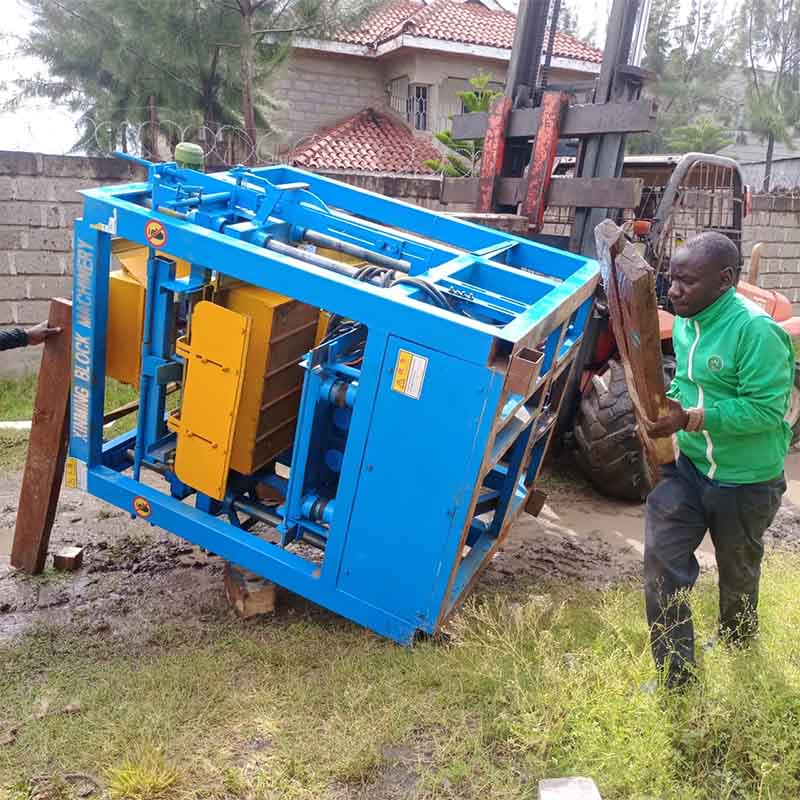
Image source Aiweibrickmachine
Case Studies: Successful Projects Using Semi-Automatic Block Machines
Concrete blocks, a fundamental building material in construction, have undergone a significant transformation in recent years, thanks to the integration of semi-automatic block machines. These versatile machines have played a crucial role in the success of various construction projects around the world. In this exploration, we dive into real-world case studies of successful projects that have harnessed the potential of semi-automatic block machines, showcasing their impact on efficiency, quality, and sustainability.
Section 1: Introduction to Semi-Automatic Block Machines
1.1 The Evolution of Block Production
Semi-automatic block machines have emerged as key players in the production of concrete blocks, bridging the gap between manual labor and full automation. Their versatility and efficiency have made them invaluable tools in construction.
1.2 The Case Study Approach
The following case studies exemplify how semi-automatic block machines have been utilized in diverse construction projects, each with its unique set of challenges and objectives.
Section 2: Case Study 1 – Affordable Housing in Emerging Economies
2.1 Project Background
In an emerging economy, a shortage of affordable housing is a pressing issue. A construction project aimed to address this challenge by building a housing complex for low-income families.
2.2 Machine Selection
Semi-automatic block machines were chosen for their cost-effectiveness and adaptability to various block sizes and designs.
2.3 Impact
- Efficiency: The semi-automatic machines significantly sped up block production, reducing project timelines.
- Affordability: The use of concrete blocks produced by these machines resulted in cost savings compared to traditional brick construction.
- Quality: The automated processes ensured consistent block quality, meeting stringent building standards.
- Sustainability: The project incorporated eco-friendly materials into block production, aligning with sustainability goals.
Section 3: Case Study 2 – Sustainable School Construction
3.1 Project Background
A project in an environmentally sensitive area aimed to construct a school building with minimal environmental impact.
3.2 Machine Selection
Semi-automatic block machines were chosen for their ability to produce blocks using recycled aggregates and for their energy-efficient operation.
3.3 Impact
- Sustainability: The project achieved its sustainability goals by utilizing recycled materials in block production.
- Energy Efficiency: The semi-automatic machines’ optimized energy consumption contributed to the project’s green credentials.
- Community Engagement: The environmentally conscious approach garnered community support and goodwill.
- Cost-Effective: Despite the focus on sustainability, the project remained cost-effective due to efficient block production.
Section 4: Case Study 3 – High-Volume Commercial Building
4.1 Project Background
A large-scale commercial project required the construction of a multi-story building with strict deadlines.
4.2 Machine Selection
Semi-automatic block machines were selected for their ability to produce high volumes of blocks while maintaining quality standards.
4.3 Impact
- Efficiency: The semi-automatic machines met the project’s high production demands, ensuring timely completion.
- Quality Control: Automated quality control processes reduced defects and rework, maintaining quality standards.
- Cost Savings: Efficient block production resulted in significant cost savings.
- Flexibility: The machines accommodated changes in block sizes and designs during the project.
Section 5: Case Study 4 – Customized Architectural Landmarks
5.1 Project Background
An architectural firm embarked on a project to create customized concrete blocks for a series of iconic landmarks.
5.2 Machine Selection
Semi-automatic block machines were chosen for their ability to produce unique block designs with precision.
5.3 Impact
- Customization: The semi-automatic machines allowed for intricate and customized block designs, elevating the aesthetics of the landmarks.
- Quality Assurance: The machines ensured consistent quality, vital for the project’s artistic and structural requirements.
- Market Differentiation: The landmarks, featuring bespoke concrete blocks, garnered significant attention and recognition.
- Sustainability: Eco-friendly materials were incorporated into block production, aligning with the firm’s sustainability ethos.
Section 6: Case Study 5 – Disaster-Resilient Infrastructure
6.1 Project Background
In an earthquake-prone region, the construction of disaster-resilient infrastructure was a top priority.
6.2 Machine Selection
Semi-automatic block machines were selected for their ability to produce earthquake-resistant blocks using specialized designs and materials.
6.3 Impact
- Safety: The earthquake-resistant blocks produced by semi-automatic machines enhanced the structural integrity of the infrastructure.
- Rapid Response: Efficient block production allowed for the swift construction of disaster-resilient buildings.
- Cost-Effective: The machines’ ability to produce specialized blocks proved cost-effective in comparison to traditional construction methods.
- Community Resilience: The project contributed to the community’s disaster preparedness and resilience.
Section 7: Case Study 6 – Affordable Housing Renovation
7.1 Project Background
A renovation project in an urban area aimed to transform old buildings into affordable housing units.
7.2 Machine Selection
Semi-automatic block machines were chosen to produce concrete blocks for the renovation, ensuring structural stability and energy efficiency.
7.3 Impact
- Revitalization: The use of concrete blocks produced by semi-automatic machines revitalized the old structures.
- Energy Efficiency: The renovated buildings featured improved insulation and energy-efficient designs, reducing long-term operational costs for residents.
- Cost-Efficient: The project’s use of semi-automatic block machines contributed to overall cost-efficiency.
Section 8: Conclusion
The case studies presented here exemplify the diverse range of construction projects that have harnessed the potential of semi-automatic block machines. These machines have proven instrumental in addressing a wide array of challenges, from housing shortages to sustainability goals, while maintaining efficiency, quality, and cost-effectiveness. As the construction industry continues to evolve, semi-automatic block machines are poised to play an even more significant role in shaping successful projects around the globe. Their adaptability, efficiency, and capacity for innovation ensure that they remain indispensable tools for architects, builders, and construction professionals striving to achieve their project objectives while pushing the boundaries of what’s possible in construction.
